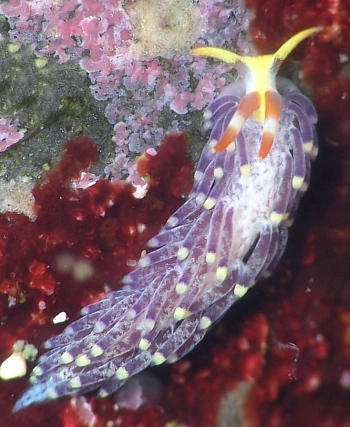

Antonietta janthina
Baba & Hamatani, 1977
Order: NUDIBRANCHIA
Suborder: AEOLIDINA
Family: Glaucidae
DISTRIBUTION
Known only from SE Japan and a possible record from East Timor.
PHOTO
Upper: Shimoda, Izu Peninsula, Sagami Bay, Japan. ( Intertidal ), Pacific Ocean, 12 September 2003, under stone. Length: 6 mm. Photographer: Jun Imamoto. Lower: Osezaki, Izu Peninsula, Suruga bay, 3 m, Japan, Pacific Ocean, 30 April 2004, on the Hydractinia epiconcha. Length: 10 mm. Photographer: Jun Imamoto.
Brightly coloured aeolid with conspicuous yellow oral tentacles and a broad median band of the same colour running across the head and between the rhinophores. The smooth rhinophores are bright orange with a slightly lighter coloured band about midway down their length. The dorsal surface of the body, between the rhinophores is translucent with a heavy speckling of opaque white. The cerata appear purple with a white or yellow tip. This colour is produced by the purple colour of the digestive gland duct which fills each ceras and yellowish pigmentation on the apical skin of the cerata. There is also irrefular patching of opaque white on the ceratal wall but it only slightly obscures the purple of the digestive gland. The foot is translucent white and anteriorly is extended in to tentacular foot corners.
The cerata appear to be arranged in rows on each side of the body but Baba & Hamatani describe the post cardiac cerata as being arranged in single rowed arches. The arrangement of the cerata is the main reason they placed this species in Antonietta, but they were clearly hesitant in doing so. This species appears to feed exclusively on the hydroid Hydractinia epiconcha, which is often found growing on shells inhabited by hermit crabs.
-
Baba, K. & Hamatani, I. (1977): A new species tentatively referred to Antonietta, Antonietta janthina, from Japan (Nudibranchia: Eolidoidea: Facelinidae). The Veliger 20(1): 9-13.
Rudman, W.B., 2006 (April 11) Antonietta janthina Baba & Hamatani, 1977. [In] Sea Slug Forum. Australian Museum, Sydney. Available from http://www.seaslugforum.net/find/antojant
Related messages
Re: Unknown aeolid is Antonietta janthina
April 18, 2008
From: Richard Swann
Concerning message #21464:
Hi Again Bill
Thanks for your time. I did more searching and thought Antonietta janthina may be a possibility ?
Kind regards
Richard
www.downbelow.co.uk.
richard@downbelow.co.uk
Swann, R., 2008 (Apr 18) Re: Unknown aeolid is Antonietta janthina. [Message in] Sea Slug Forum. Australian Museum, Sydney. Available from http://www.seaslugforum.net/find/21534Thanks Richard,
I knew I had seen it before - it's almost identical to the photo in Brian Francisco's message [#16175] from East Timor. I hate 'unidentifieds' so thanks for solving it yourself!
Best wishes,
Bill Rudman
Unknown aeolid from Borneo
April 17, 2008
From: Richard Swann
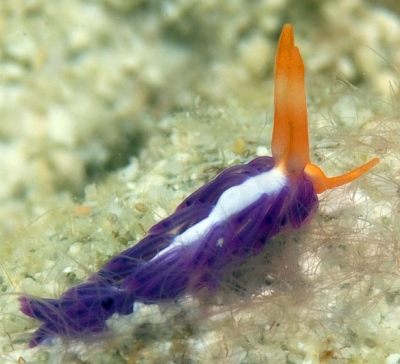
Hi Bill
I am hoping you can find a little time to help me id this slug ? i have had a good look through the forum but can't quite seem to match it up.
Locality: Kapalai island, 11 meters, Sabah, Borneo, Celebes Sea, 14 March 2008, Sheltered reef. Length: around 5 mm. Photographer: Richard Swann.
I guess it is some kind of Flabellina but i am just not sure.
Thanks for your help
Kind regards
Richard
www.downbelow.co.uk
richard@downbelow.co.uk
Swann, R., 2008 (Apr 17) Unknown aeolid from Borneo. [Message in] Sea Slug Forum. Australian Museum, Sydney. Available from http://www.seaslugforum.net/find/21464Note added 18 April 2008: This is Antonietta janthina [see message #21534]
Dear Richard,
I have the nagging feeling I have seen this before but I can't remember where. The proportionally huge rhinophores suggest this is a juvenile of a species which grows quite a bit larger than 5 mm but I can't get enough clues from the photo to guess a family. The only think that looks familar is the colour of the head and rhinophores which remind me of the orange colour form of Cuthona yamasui.
If anyone has any ideas they would be very welcome
Best wishes,
Bill Rudman
Re: Cuthona? from East Timor is Antonietta
April 13, 2006
From: Jun Imamoto
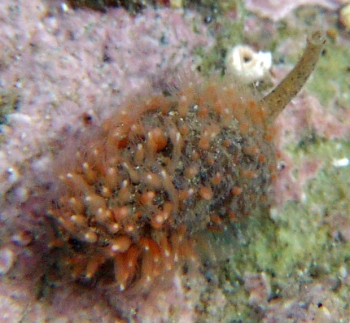
Concerning message #16267:
Dear Bill,
Thank you for your advice.
Concerning your question "Are they photographed on a rock or is it a large shell?"
In those photos they were fastened to a rock, but sometimes they grow on snail shells as well. Here are some photos of Hydractinia epiconcha growing on the shell of a living snail.
Locality: Shimoda, Izu Peninsula, Sagami Bay, 0.5m, Japan, Pacific Ocean, 15 December 2001, Intertidal. Length: 12mm. Photographer: Jun Imamoto.
Best wishes,
Jun Imamoto
http://www.umiushi.info/
imamoto@umiushi.info
Imamoto, J., 2006 (Apr 13) Re: Cuthona? from East Timor is Antonietta. [Message in] Sea Slug Forum. Australian Museum, Sydney. Available from http://www.seaslugforum.net/find/16302
Dear Jun,
Thanks for these photos. I mentioned the very similar European Hydractinia echinata in my comments on your earlier message. It is interesting that H. echinata is eaten by Cuthona nana, and on the west coast of Nth America another Hydractinia is eaten by Cuthona divae, both aeolids from a completely different family from A. janthina. I have searched many Nassarius snails with Hydractinia growing on their shells here in Australia, but have yet to find any aeolid interested in them as food.
Best wishes,
Bill Rudman
Another Antonietta janthina from Japan
April 11, 2006
From: Jun Imamoto
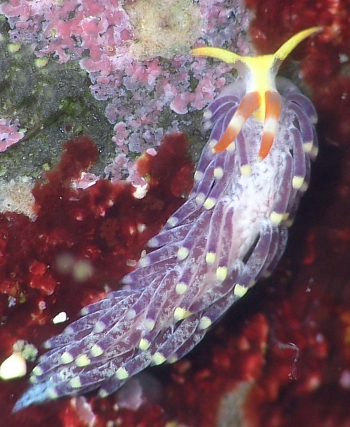
Concerning message #16267:
Dear Bill,
Here is another photo of Antonietta janthina.
Locality: Shimoda, Izu Peninsula, Sagami Bay, 0.3-0.5 ( Intertidal ) m, Japan, Pacific Ocean, 12 September 2003, back of stone. Length: 6mm. Photographer: Jun Imamoto.
Best wishes,
Jun Imamoto
http://www.umiushi.info/
imamoto@umiushi.info
Jun Imamoto, 2006 (Apr 11) Another Antonietta janthina from Japan. [Message in] Sea Slug Forum. Australian Museum, Sydney. Available from http://www.seaslugforum.net/find/16268Dear Jun,
Thanks for this nice photo.
Best wishes,
Bill Rudman
Cuthona? from East Timor is Antonietta
April 11, 2006
From: Jun Imamoto

Concerning message #16175:
Dear Bill,
Brian Francisco's sea slug reminds me of Antonietta janthina. Is the genus
Antonietta, still appropriate for this species? This photo confirms Baba & Hamatani's mention (1977) that it feeds on Hydractinia epiconcha.
Locality: Osezaki, Izu Peninsula, Suruga bay, 3 m, Japan, Pacific Ocean, 30 April 2002, on Hydractinia epiconcha. Length: 10 mm. Photographer: Jun Imamoto.
Best wishes,
Jun Imamoto
http://www.umiushi.info/
imamoto@umiushi.info
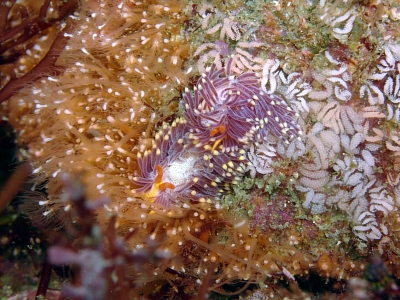


Dear Jun,
I think you are right. The basic colours are the same and the rhinophores, with a paler band about midway down are identical. I think it is the first record outside of Japan.
This is a spectacular photo. I wouldn't be surprised if all the eggs have been produced by these two animals. With such a plentiful supply of food all they need to do is eat and breed. Are they photographed on a rock or is it a large shell? Baba & Hamatani's specimen was feeding on this hydroid growing on a shell and the name 'epiconcha' suggests it lives on shells. I just wondered whether it was like the European Hydractinia echinata, which is often found on shells, but on rocks as well.
Concerning your question about whether the genus is correct. Baba & Hamatani were not sure if this was the appropriate genus in which to place their species, but I know of no later studies suggesting an alternative. Thanks for this new addition to the Forum
Best wishes,
Bill Rudman
Cuthona? from East Timor
April 5, 2006
From: Brian Francisco
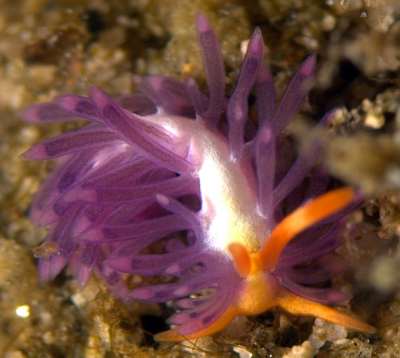

Hi Bill
Is this a juvenille Flabellina?
Locality: K-41, 17 meters, East Timor, Banda Sea, 25 March 2006, coral reef. Length: 4-5mm. Photographer: Brian Francisco.
Thanks
Brian
francisco.brian@gmail.com
Francisco, B., 2006 (Apr 5) Cuthona? from East Timor. [Message in] Sea Slug Forum. Australian Museum, Sydney. Available from http://www.seaslugforum.net/find/16175
Dear Brian,
This is a quite a spectacularly coloured aeolid which I am sure is an adult, even though of small size. Although the rhinophores look a little out of proportion - a little long for an animal this size- the cerata are well organised and numerous. I am afraid I don't recognise it and I can't see anything of the front of the foot, but my guess would be that it is a species of Cuthona
Best wishes,
Bill Rudman
